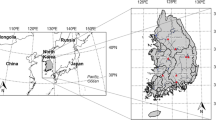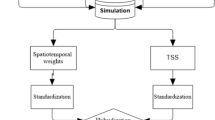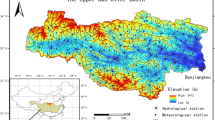Abstract
Current drought studies have already used the concept of equal ensemble streamflow prediction, but lack other kinds of ensemble prediction models for comparison of drought probabilistic prediction. Therefore, in this paper, an equal ensemble drought prediction (EEDP) model, a weighted ensemble drought prediction (WEDP) model, and a conditional ensemble drought prediction (CEDP) model were established and elaborately compared for drought prediction. The EEDP model directly uses the concept of ensemble streamflow prediction and assigns an equal weight to each ensemble member. The WEDP model assigns weights to ensemble members given the similarity of climate indexes between the historical and forecast year. The CEDP model considers the climate information as predictors and generates conditional ensembles of drought given the climate indexes. The verification of the proposed models was carried out using 26 meteorological stations in Jiangxi province (China), using the standard precipitation index to depict meteorological drought conditions in October, November, and December. The results show that compared to the EEDP model, the WEDP and CEDP models remarkably improved the accuracy and reduced the uncertainty of the drought prediction, indicating that a model considering climate information is much better than a purely statistical model. Meanwhile, the CEDP model outperformed the WEDP model in parameter estimation and accuracy. The prediction in southern Jiangxi province gets the best results compared with other regions. Our results provide a basis for drought planning and management in Jiangxi province.






Similar content being viewed by others
References
AghaKouchak A (2015) A multivariate approach for persistence-based drought prediction: application to the 2010–2011 East Africa drought. J Hydrol 526(S1):127–135. https://doi.org/10.1016/j.jhydrol.2014.09.063
Allen BA, Mohamed H, Schwartz SS (2015) Climate index weighting of ensemble streamflow forecasts using a simple Bayesian approach. Water Resour Res 51(9):7382–7400. https://doi.org/10.1002/2014WR016811
Armal S, Devineni N, Khanbilvardi R (2018) Trends in extreme rainfall frequency in the contiguous United States: attribution to climate change and climate variability modes. J Clim 31(1):369–385
Belayneh A, Adamowski J, Khalil B, Ozga-Zielinski B (2014) Long-term SPI drought forecasting in the awash river basin in Ethiopia using wavelet neural network and wavelet support vector regression models. J Hydrol 508(2):418–429
Beven K, Binley A (1992) The future of distributed models: model calibration and uncertainty prediction. Hydrol Process 6(3):279–298
Chen X, Hao Z, Devineni N, Lall U (2014) Climate information based streamflow and rainfall forecasts for Huai river basin using hierarchical bayesian modeling. Hydrol Earth Syst Sci 18(4):1539–1548. https://doi.org/10.5194/hess-18-1539-2014
Chunlin W, Jing G, Fang Z, Jiali D (2011) An improved comprehensive meteorological drought index CI and its applicability analysis. Chin J Agrometeorol 32(4):621–626
Damberg L, AghaKouchak A (2014) Global trends and patterns of drought from space. Theoret Appl Climatol 117(3–4):441–448. https://doi.org/10.1007/s00704-013-1019-5
D’Arrigo R, Smerdon JE (2008) Tropical climate influences on drought variability over Java, Indonesia. Geophys Res Lett 35(5):475
Durdu ÖF (2010) Application of linear stochastic models for drought forecasting in the Büyük Menderes river basin, Western Turkey. Stoch Environ Res Risk Assess 24(8):1145–1162
Feng L, Hu C, Chen X, Cai X, Tian L, Gan W (2012) Assessment of inundation changes of Poyang lake using modis observations between 2000 and 2010. Remote Sens Environ 121(2):80–92
Feng C et al (2015) Tree-ring recorded hydroclimatic change in Tienshan mountains during the past 500 years. Quat Int 358:35–41
Feng C, Mambetov B, Maisupova B, Kelgenbayev N (2017) Drought variations in Almaty (Kazakhstan) since AD 1785 based on spruce tree rings. Stoch Environ Res Risk Assess 31(8):2097–2105
Ganguli P, Reddy MJ (2015) Ensemble prediction of regional droughts using climate inputs and the SVM–copula approach. Hydrol Process 28(19):4989–5009
Grimaldi S, Serinaldi F (2006) Asymmetric copula in multivariate flood frequency analysis. Adv Water Resour 29(8):1155–1167
Guo SP, Zhuang H, Zheng CW, Jia BK, Chen ZL, Wang J (2012) The relationship between El Nino and wave field in the South China sea. Mar Forecasts 29(6):37–43
Guo Y, Li J, Li Y (2013) Seasonal forecasting of north china summer rainfall using a statistical downscaling model. J Appl Meteorol Climatol 53(7):1739–1749
Hao Z, Aghakouchak A (2013) Multivariate standardized drought index: a parametric multi-index model. Adv Water Resour 57(9):12–18
Hao Z, Hao F, Singh VP (2016) A general framework for multivariate multi-index drought prediction based on multivariate ensemble streamflow prediction (mesp). J Hydrol 539:1–10
Hong X, Guo S, Zhou Y, Xiong L (2015) Uncertainties in assessing hydrological drought using streamflow drought index for the upper Yangtze river basin. Stoch Environ Res Risk Assess 29(4):1235–1247. https://doi.org/10.1007/s00477-014-0949-5
Hongsheng Y, Rong JI, Ting W (2008) Atmospheric circulation background and long-term prediction of grasshopper occurrence in Xinjiang. Chin J Ecol 27(2):218–222
Huang G (2001) On the drought disaster in Jiangxi province (in Chinese). J Catastrophol 16(1):65–70
Lavers D, Luo L, Wood EF (2009) A multiple model assessment of seasonal climate forecast skill for applications. Geophys Res Lett 36(23):239–252
Li X, Yao J, Li Y, Zhang Q, Xu CY (2016) A modeling study of the influences of Yangtze river and local catchment on the development of floods in Poyang lake, China. Hydrol Res 47(S1):102–119
Lima CHR, Aghakouchak A (2017) Droughts in amazonia: spatiotemporal variability, teleconnections, and seasonal predictions. Water Resour Res 53(7):10824–10840
Liu Y, Hwang Y (2015) Improving drought predictability in Arkansas using the ensemble PDSI forecast technique. Stoch Environ Res Risk Assess 29(1):79–91. https://doi.org/10.1007/s00477-014-0930-3
Liu X, Lin XP (2013) The sea surface temperature seesaw pattern in South China sea during Enso. Period Ocean Univ China 43(12):1–6
Liu D, Guo S, Lian Y, Xiong L, Chen X (2014) Climate-informed low-flow frequency analysis using nonstationary modelling. Hydrol Process 29(9):2112–2124
Livezey RE, Timofeyeva MM (2008) The first decade of long-lead U.S. seasonal forecasts. Bull Am Meteorol Soc 89(6):843–854
Mckee TB, Doesken NJ, Kleist J (1993) The relationship of drought frequency and duration to time scales. Paper presented at the American Meteorological Society, California, pp 179–184
Mishra AK, Desai VR, Singh VP (2007) Drought forecasting using a hybrid stochastic and neural network model. J Hydrol Eng 12(6):626–638
Modarres R (2007) Streamflow drought time series forecasting. Stoch Environ Res Risk Assess 21(3):223–233. https://doi.org/10.1007/s00477-006-0058-1
Murtagh F, Legendre P (2014) Ward’s hierarchical agglomerative clustering method: which algorithms implement ward’s criterion? J Classif 31(3):274–295
Najafi MR, Moradkhani H, Piechota TC (2012) Ensemble streamflow prediction: climate signal weighting methods vs. climate forecast system reanalysis. J Hydrol 442(5):105–116. https://doi.org/10.1016/j.jhydrol.2012.04.003
Nicault A, Alleaume S, Brewer S, Carrer M, Nola P, Guiot J (2008) Mediterranean drought fluctuation during the last 500 years based on tree-ring data. Clim Dyn 31(2–3):227–245
Palmer W (1965) Meteorological drought. Research Paper No 45, US Department of Commerce Weather Bureau, Washington, DC
Qin Z, Tang H, Li W, Zhang H, Zhao S, Wang Q (2014) Modelling impact of agro-drought on grain production in china. Int J Disaster Risk Reduct 7(4):109–121
Renard B, Lang M (2007) Use of a gaussian copula for multivariate extreme value analysis: some case studies in hydrology. Adv Water Resour 30(4):897–912. https://doi.org/10.1016/j.advwatres.2006.08.001
Sheffield J, Wood EF (2008) Global trends and variability in soil moisture and drought characteristics, 1950–2000, from observation-driven simulations of the terrestrial hydrologic cycle. J Clim 21(3):432–458
Shen W, Yan B, Xie D (2012) Influence of drought disaster on agriculture development in Jiangxi province and its protective countermasures. Resour Environ Yangtze Basin 21(7):905–910
Shukla S, Wood AW (2008) Use of a standardized runoff index for characterizing hydrologic drought. Geophys Res Lett 35(2):226–236
Stedinger JR, Kim YO (2010) Probabilities for ensemble forecasts reflecting climate information. J Hydrol 391(1):9–23
Theil H, Cramer JS (1961) Economic forecasts and policy. J Am Stat Assoc 14(1):359–368
Wang E, Zhang Y, Luo J, Chiew FHS, Wang QJ (2011) Monthly and seasonal streamflow forecasts using rainfall-runoff modeling and historical weather data. Water Resour Res 47(5):1296–1300
Wang S, Sun X, Lall U (2017) A hierarchical bayesian regression model for predicting summer residential electricity demand across the U.S.A. Energy 140:601–611
Werner K, Brandon D, Clark M, Gangopadhyay S (2004) Climate index weighting schemes for NWS ESP-based seasonal volume forecasts. J Hydrometeorol 5(6):1076–1090
Xiong LH, Wan M, Wei XJ, O’Connor KM (2009) Indices for assessing the prediction bounds of hydrological models and application by generalised likelihood uncertainty estimation. Hydrol Sci J 54(5):852–871. https://doi.org/10.1623/hysj.54.5.852
Xiong L, Yu KX, Gottschalk L (2015) Estimation of the distribution of annual runoff from climatic variables using copulas. Water Resour Res 50(9):7134–7152
Xu KQ, Brown C, Kwon HH, Lall U, Zhang JQ, Hayashi S, Chen ZY (2007) Climate teleconnections to Yangtze river seasonal streamflow at the three gorges dam, China. Int J Climatol 27(6):771–780. https://doi.org/10.1002/joc.1437
Ye X, Xu C-Y, Zhang Q, Yao J, Li X (2018) Quantifying the human induced water level decline of china’s largest freshwater lake from the changing underlying surface in the lake region. Water Resour Manag 32(4):1467–1482. https://doi.org/10.1007/s11269-017-1881-5
Yong L, Yintang W, Yuanfang C, Zongzhi W, Hujian F (2010) Long-term runoff forecasting for Autuan flooding season in Danjiangkou on reservoir based on physical cause (in Chinese). Adv Water Sci 21(6):771–778
Yoon JH, Mo K, Wood EF (2012) Dynamic-model-based seasonal prediction of meteorological drought over. J Hydrometeorol 13(2):463–482. https://doi.org/10.1175/Jhm-D-11-038.1
Zeng H, Sun X, Lall U, Feng P (2017) Nonstationary extreme flood/rainfall frequency analysis informed by large-scale oceanic fields for Xidayang reservoir in north China. Int J Climatol 37(10):3810–3820. https://doi.org/10.1002/joc.4955
Zhang L, Singh VP (2006) Bivariate flood frequency analysis using the copula method. J Hydrol Eng 11(2):150–164
Zhang Q, Gu X, Singh VP, Xiao M, Chen X (2015) Evaluation of flood frequency under non-stationarity resulting from climate indices and reservoir indices in the east river basin, China. J Hydrol 527:565–575
Zhang YQ, You QL, Ye L, Chen CC (2017) Spatio-temporal characteristics and possible mechanisms of rainy season precipitation in Poyang lake basin, China. Clim Res 72(2):129–140. https://doi.org/10.3354/cr01455
Zhao S, Cong D, He K, Yang H, Qin Z (2017) Spatial–temporal variation of drought in china from 1982 to 2010 based on a modified temperature vegetation drought index (MTVDI). Sci Rep 7(1):1–12
Zhi-Yao HE, Yang MX, Chen-Ming LI, Wang H, Lei XH (2017) Annual average runoff ensemble forecast for Jinping i-stage hydropower station based on Elman neural network. Water Resour Power 35(10):25–28
Zhou H, Liu YB (2018) Spatio-temporal pattern of meteorological droughts and its possible linkage with climate variability. Int J Climatol 38(4):2082–2096. https://doi.org/10.1002/joc.5319
Zhou M, Tian F, Lall U, Hu H (2011) Insights from a joint analysis of Indian and Chinese monsoon rainfall data. Hydrol Earth Syst Sci 15(8):2709–2715. https://doi.org/10.5194/hess-15-2709-2011
Zhuo H, Yan D, Yanling W, Haiming X (2013) Asymmetric response of the South China sea SST to El Nino and La Nina. J Ocean Univ China 12(2):272–278
Acknowledgements
This research is financially supported by the National Key R&D Program of China (Grant Nos. 2016YFC0402708, 2017YFA0603704), National Nature Science Foundation of China (Grant Nos. 51439007, 91647119), and Innovation group of Hubei Natural Science Foundation (Grant No. 2017CFA015). The authors declare that there is no conflict of interests regarding the publication of this article.
Author information
Authors and Affiliations
Corresponding author
Additional information
Publisher's Note
Springer Nature remains neutral with regard to jurisdictional claims in published maps and institutional affiliations.
Rights and permissions
About this article
Cite this article
Zhang, X., Dong, Q. & Chen, J. Comparison of ensemble models for drought prediction based on climate indexes. Stoch Environ Res Risk Assess 33, 593–606 (2019). https://doi.org/10.1007/s00477-019-01650-w
Published:
Issue Date:
DOI: https://doi.org/10.1007/s00477-019-01650-w




